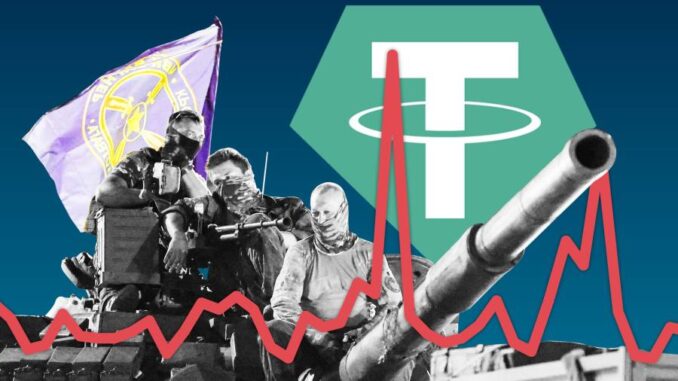
Receive free Cryptocurrencies updates
We’ll send you a myFT Daily Digest email rounding up the latest Cryptocurrencies news every morning.
The volume of trade between the Russian rouble and the largest dollar-pegged crypto token surged during the attempted insurrection by the Wagner Group earlier this month, as Russians rushed to find an alternative to the country’s weakening currency.
The militia group’s leader Yevgeny Prigozhin cast doubt on Vladimir Putin’s grip on Russia by attempting the country’s first coup for three decades. The insurrection ultimately failed, and Wagner has since relocated to Belarus.
On June 24, the day Prigozhin’s militia made its move on Moscow, daily trading volumes between the rouble and the Tether stablecoin surged, according to figures from data provider CCData.
Stablecoin is a type of cryptocurrency that tracks the dollar and allows traders to move assets in and out of the crypto market.
Trading volumes between Tether’s coin and the rouble were $14.7mn on June 24, up 277 per cent from $3.9mn 24 hours earlier. The following day, when Prigozhin ordered his forces to halt after the Putin deal, trading volumes fell back below $3mn.
The surge came as Russians withdrew more than $1bn from local banks, according to the country’s central bank. The rouble has lost approximately a third of its value since December and was trading at more than 90Rbs per US dollar this month, its lowest point since Putin launched his full-scale invasion of Ukraine last year.
Dollar-pegged cryptocurrencies can provide an alternative store of value in heavily sanctioned economies.
The beneficiaries of the trades are not known, but the rouble-Tether moves “strongly reinforce the idea that crypto is used by nefarious actors trying to play outside mainstream finance”, said Charley Cooper, a former chief of staff at the Commodity Futures Trading Commission, a US government agency.
Anxieties over the links between digital assets and rogue elements have been fuelled by an increasingly sophisticated North Korean regime leveraging cryptocurrencies to help finance its illicit ballistic weapons programme.
Earlier this year US prosecutors arrested the Russian founder of crypto exchange Bitzlato, described by authorities as a “crucial financial resource” to the dark net.
The EU last month agreed on an 11th package of sanctions against Russia that builds on efforts by G7 nations to up pressure on Moscow over the Ukraine war.
“The argument was that sanctions may increase . . . and therefore we should put our assets into crypto while we can,” said Arda Akartuna, senior cryptocurrency threat analyst at blockchain tracing company Elliptic. He said there was a “similar motivation in Afghanistan when the Taliban took over”.
The volume recorded on June 24 represented the highest point between both assets since July 2022 when it reached more than $21mn. In the weeks immediately following the invasion in February last year, volume also surged to $37.9mn.
Recommended
“Crypto is being used to buy hosting, it’s being used to buy domains, it’s being used to buy materials on the dark web and servers on the dark web . . . things that you actually need to stand up a strong cyber attack ecosystem,” said Erin Plante, vice-president of investigations at blockchain tracing firm Chainalysis.
“It’s also a target, in that you’re trying to acquire crypto so you can evade sanctions, so you can make purchases in non-attributable ways.”
Private crypto fundraising for pro-Ukrainian causes outpaced Russian equivalents by a rate of 44 to one over the past year, according to data from Elliptic. More than $200mn worth of crypto had been donated to pro-Ukraine causes.
One Wagner-affiliated paramilitary group, Rusich, was identified as trying to extort the families of lost loved ones by promising coordinates of their dead relatives in exchange for cryptocurrency.







Be the first to comment